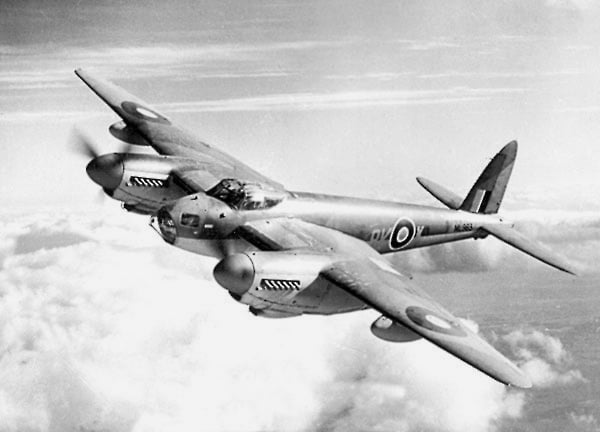Old and New Aviation
This week, I have a great collection of articles for you to read, ranging from World War II to A.I. fighter pilots.
Surviving War’s End by Werner Schwantje is a great story expanded into Survivor on the Canadian site, Vintage Wings.
His name was Werner Schwantje, an elegant, well-turned out 70-something government lawyer with Revenue Canada. I had been expecting him to drop in and hand over a photo of himself to scan as a reference for a and ink and pencil illustration for the book (lead image to this story). I had grown up with stories of heroic RAF and RCAF pilots fighting the Nazis back to Berlin and Werner Schwantje would be the first German combat veteran I had ever met. I have to admit my expectations of what he would be like were coloured by a childhood filled with images of duel-scarred, grey-eyed, Ritterkreuz-wearing, cold killers flying mottled and ugly-beautiful Messerschmitts and Focke Wulfs. I would not have been surprised by a heel click, a monocle or a sneer. But Werner was none of that.
3,2,1…Now! in the NATS blog tells the story behind Heathrow’s parallel runway take-off with videos of the monitors and the views from Heathrow Tower. This is an interesting account from a side of aviation we don’t often get to experience.
For us there were two priorities – making sure it could be done safety (which is always paramount) and working out how to do it in perfect sync, with both aircraft starting their roll down the runway and ‘rotating’ – i.e. lifting off – at the same time.
I love this story sent to me by Petrea: The Owners of a Brewery Put a Crashed Airplane on Display in Their New Portland Pub. Then the Air Force Came Looking for It.
“We were all down in the office for our manager meeting,” says general manager Kyle Jensen, “and the bartender comes in and very timidly says, ‘Uh, there’s three guys from the Air Force here to see you.’”
The Rise of A.I. Fighter Pilots by Sue Halpern in The New Yorker explores a much more modern opportunity.
Algorithms are already good at flying planes. The first autopilot system, which involved connecting a gyroscope to the wings and tail of a plane, débuted in 1914, about a decade after the Wright brothers took flight. And a number of current military technologies, such as underwater mine detectors and laser-guided bombs, are autonomous once they are launched by humans. But few aspects of warfare are as complex as aerial combat. Paul Schifferle, the vice-president of flight research at Calspan, the company that’s modifying the L-39 for darpa, said, “The dogfight is probably the most dynamic flight profile in aviation, period.”
And thank you to Andrew for this one from Popular Mechanics: How I Restored a Legendary Wooden WWII Fighter Plane
My friend, Glyn Powell, brought the original Mossie restoration project to life almost single-handedly. He spent years gathering Mosquito fragments, manuals, parts, and plans from all over the globe in hopes to one day resurrect his own. His main challenge was tracking down the Mossie’s unique laminated-plywood, tapered cigar-shaped fuselage molds. Almost all of the cumbersome and heavy molds disappeared or were destroyed after World War II. Glyn devoted all of his time—seven days a week for maybe 10 years—to scouring the world for the drawings he needed to build the mold.
I’m collecting questions for the next edition of Questions and Answers so if there’s a question that has been bothering you, please don’t be shy! You can use the contact form or email me if you would prefer not to post it as a comment.
I hope you’ve enjoyed the articles! If you know of other content that you think we would all enjoy, please leave a link* in the comments.
(*Note: if you leave three links or more, you’ll get tossed into the moderation queue. Be patient, I’ll publish the comment as soon as I see it.)











Two quotes from “Survivor”:
Wow! These are all golden! There goes the rest of the night…
Thank you.
Suggestion for the next “Questions and Answers”: how big a problem is 5G interference with avionics, and how much is just media hype?
Here’s a representative article on the subject:
https://www.thedrive.com/the-war-zone/43917/the-5g-fiasco-from-an-airline-pilots-point-of-view
Re the AI pilots, when I was shown a military simulator in the Military Institute of Aviation Medicine in Warsaw, folks working on it told me that the opponent AI regularly hands actual fighter pilots their asses in a basket – it was not invincible but good enough to defeat an average lieutenant. Mind you, it was simulating a human-controlled airplane so subject to the same g-force restrictions.
It was in 1995 and the simulation ran on three 386 DX-40 PCs. So I guess reasons why we don’t have AI-controlled fighters yet are mostly ethical in nature and also I suppose because most decision-makers everywhere are invested in the current model.
It sounds as though that AI was just simulating an adversary in a dogfight. It’s much more difficult to develop an AI that can handle all the decision-making that is required throughout a mission, including deciding when to engage enemies and when not, identifying hostiles and friendlies, and responding to unexpected developments like system failures or the the target not being where it was expected to be. It’s even more difficult to do that so reliably that people will trust the AI with the same responsibilities as a human pilot.
That raises the question of why we haven’t seen the development of limited domain AIs that will just take over for one part of a mission, e.g. pilot spots an enemy fighter and activates a dogfight AI that can make decisions faster than a human being to win the fight. Perhaps that is something that runs into cultural opposition because pilots aren’t willing to trust their lives to an AI in those moments, or maybe the cost-benefit calculation isn’t favourable compared to remotely-piloted systems or focussing on the development of fully autonomous UAVs.
The biggest difference between a simulation AI adversary and an actual AI pilot is that the sim AI doesn’t need to deal with uncertainty because it has access to 100% accurate simulation data. It can’t lose track of its adversary or be affected by countermeasures. It has no equipment failures. And it probably didn’t need to deal with more than one adversary at a time.
It’s kind of like with cars: having AI cars in racing games for decades doesn’t mean working street car AI is easy.